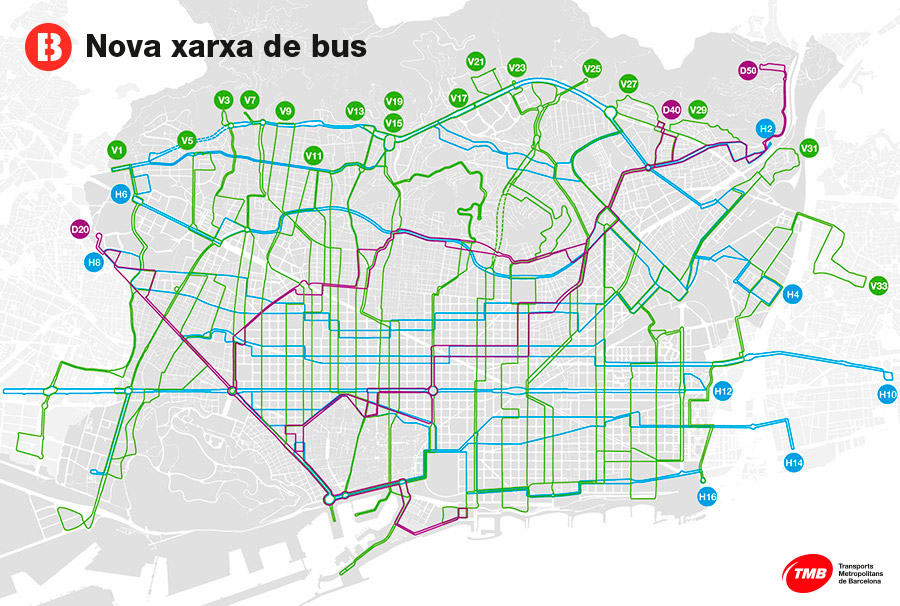What it is and the completed bus network
What is the new bus network?
The new bus network is a project to redesign the Barcelona bus network according to criteria of ease of use, efficiency and resource management. Now that it has been fully introduced, passengers have a more intelligible bus network with shorter waiting and journey times and improved links between modes of transport, all of which makes for a more attractive and sustainable public transport system.
Now the project is fully operational, the new bus network comprise 28 high performance lines; 17 vertical (sea-mountain), 8 horizontal (Llobregat-Besòs) and 3 diagonal.
Features
The main features of the new bus network are:
- Faster, thanks to a series of measures that have been introduced, such as designated bus lanes, priority at traffic lights and double stops.
- Easier to use, as new bus lines follow straighter, more direct routes, designed to increase the efficiency and logic of the layout, to make travel smoother for users.
- Great links and better intermodality, as the network covers the city completely, from the Llobregat to the Besòs and from the sea to Collserola. And it provides better links with other bus routes and other modes of public transport (metro, FGC, Tram, etc.).
- More frequent, buses run more often (every 5 to 8 minutes) and services have been extended, which means shorter waiting times at stops.
- Gradual introduction of new lines in stages until all 28 lines planned for the new network are operational.
- Interchange hubs: the points where vertical, horizontal and diagonal bus routes intersect, in both directions, are called interchange hubs. Here changing buses is quick and easy.
Where we've been
Introduction of the new bus network
Five lines in 2012
Two horizontal, two vertical and one diagonal line covering a total of 88.8 kilometres started running on 1 October.
- H12 (Gornal - Besòs/Verneda)
- H6 (Zona Universitària - Fabra i Puig)
- V7 (Plaça Espanya - Sarrià)
- V21 (Passeig Marítim - Montbau)
- D20 (Passeig Marítim - Ernest Lluch)
Five lines in 2013
Three horizontal and two vertical lines, covering a total of 98 kilometres, entered service on 18 November.
- H8 (Camp Nou - La Maquinista)
- H10 (Badal - Olímpic de Badalona)
- H16 (Paral·lel - Fòrum)
- V3 (Zona Franca - Can Caralleu)
- V17 (Port Vell - Carmel)
Three lines in 2014
On 15 September, three new lines (one horizontal and two vertical) started running:
- H14 (Paral·lel - Sant Adrià)
- V15 (Vall d'Hebron - Barceloneta)
- V27 (Canyelles - Pg. Marítim)
Besides one horizontal line from the previous phase was restructured:
- H16 (Pg. Zona Franca - Fòrum)
Three lines in 2016
Three new lines (one horizontal and two vertical) started running on 29 February 2016.
- H4 (Zona Universitària - Bon Pastor)
- V11 (Estació Marítima - Bonanova)
- V13 (Drassanes - Av. Tibidabo)
Four lines in 2017
Four more bus lines entered service in autumn 2017: three vertical and one diagonal line.
- V5 (Mare de Déu del Port - Pedralbes)
- V29 (Fòrum - Roquetes)
- V31 (Mar Bella - Trinitat Vella)
- D40 (Pl. Espanya - Roquetes)
Eight lines in 2018
Three new lines started running on 25 June (one diagonal and two vertical):
- D50 (Paral·lel - Ciutat Meridiana)
- V9 (Sarrià - Poble-sec)
- V33 (Fòrum / Campus Besòs - Santa Coloma)
Besides five new bus lines entered service on 26 November (one horizontal and four verticals):
- H2 (Av. d'Esplugues - Trinitat Nova)
- V1 (Gran Via l'Hospitalet - Av. d'Esplugues)
- V19 (Barceloneta - Pl. Alfonso Comín)
- V23 (Poblenou - Can Marcet)
- V25 (Poblenou - Horta)
The completed bus network
The completion of the final phase finished in autumn 2018, when the Barcelona bus network comprise 97 lines: 43 urban and inter-city lines, 26 Bus de Barri or neighbourhood buses and 28 high performance lines.
In the final phase changes were made to eight existing bus routes: H6, H8, H10, H14, H16, V13, V15 and V17. Of the 43 conventional lines, 30 manteined their current route and the other 13 runned on altered routes. The route of one neighbourhood bus was altered and three new ones were ;created.
This means that 95% of the population have a more versatile, high performance bus service available with various options between the same points.


















